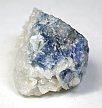 , unpolarized
from a cleavage face.
Crestmore, Riverside County, California,
, unpolarized
from a cleavage face.
Crestmore, Riverside County, California, The color of calcite can be due to its iron content which is present as Fe2+, to Mn2+, to radiation damage centers which often involve rare-earth or other elements, or occasionally to other elements such as Co2+ in what is commonly called cobaltian calcite.
Siderite owes its color to Fe2+
The color of rhodochrosite is due to its Mn2+ content. Most minerals with Mn2+ in six-coordination are pale pink. Because Mn2+ does not absorb light strongly, a mineral must have a high Mn2+ concentration to be strongly colored by Mn2+. Because some rhodochrosite specimens have a high degree of transparency, light can penetrate deep into the crystal and be highly absorbed in the appropriate wavelengths.
 , unpolarized
from a cleavage face.
Crestmore, Riverside County, California,
, unpolarized
from a cleavage face.
Crestmore, Riverside County, California,  unpolarized from
a cleavage face. Union Company Reef, Maldon, Victoria, Australia.
Museum Victoria M1036.
unpolarized from
a cleavage face. Union Company Reef, Maldon, Victoria, Australia.
Museum Victoria M1036. .
Locality not specified, but probably Colorado. Data Files: a,
0K;
.
Locality not specified, but probably Colorado. Data Files: a,
0K; Back
to the Index of Data Files
Back
to the Index of Data Files